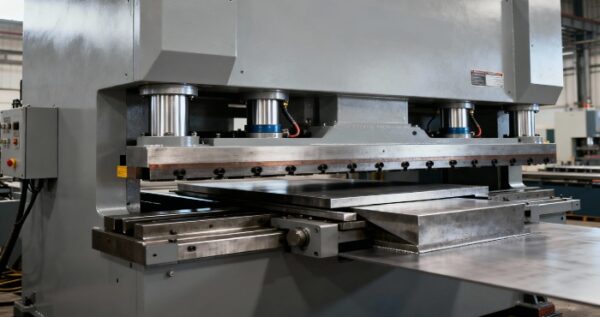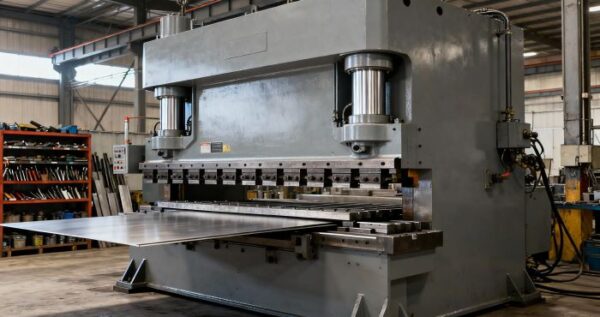In today’s rapidly evolving manufacturing landscape, precision and efficiency are vital for achieving success. One of the key machines that drives industrial productivity in sheet metal fabrication is the brake press. From crafting intricate components for aerospace applications to producing durable parts for the automotive and construction sectors, brake presses play a crucial role in shaping the world around us through advanced sheet metal fabrication.
This article delves into the basics of brake press functionality, the technological progress influencing the sector, and the importance of precise bending in the competitive manufacturing arena of today.
Understanding the Brake Press: The Backbone of Metal Bending
A brake press, also known as a press brake, is a type of machine tool employed for bending sheet and plate materials, primarily sheet metal. It achieves this by exerting force using a punch and die setup, allowing for the creation of exact angles and shapes essential for various industrial and consumer applications.
Operation of a Brake Press
Fundamentally, a brake press operates by utilising either mechanical or hydraulic pressure to drive a punch (the upper tool) into a die (the lower tool), which secures the sheet metal. This action results in a precise bend at a designated angle. The final shape and accuracy of the bend depend on the force applied, the design of the die, and the punch’s positioning.
Key Components of a Brake Press
Frame:
The frame constitutes the essential structure of the brake press, delivering the necessary strength and stability for precise bending. It supports all primary components while absorbing the forces generated during the shaping process.
Ram (Slide):
The ram is the dynamic part that pushes the punch into the material to produce bends. It functions through mechanical, hydraulic, or servo-driven systems to facilitate accurate and controlled movement.
Bed:
The bed is the stable base that securely holds the die in position during use. It endures and distributes the bending forces applied by the ram, ensuring consistent accuracy in the forming process.
Back Gauge:
The back gauge serves as a positioning aid that ensures each workpiece is aligned correctly for uniform bends. It boosts productivity and consistency by automating the alignment of materials.
Punch and Die Set:
The punch and die set is central to the bending process, shaping the metal into the required angle or profile. Offered in various designs and materials, they can be customised for specific bending tasks and materials.

Types of Brake Press Machines
Advancements in technology have resulted in the creation of various brake presses, each tailored to fulfill distinct production requirements and precision standards.
1. Mechanical Brake Press
Mechanical brake presses operate using a flywheel that an electric motor powers to produce energy, which is transmitted to the ram via a crank system.
Pros:
- High-speed operation optimal for repetitive tasks
- Cost-efficient for small to mid-sized production runs
- Easy to set up and maintain
Cons:
- Limited control over stroke
- Not ideal for intricate bends or deep formations
2. Hydraulic Brake Press
Hydraulic presses utilise fluid pressure to manage ram movement, providing enhanced accuracy and adaptability compared to mechanical models.
Pros:
- Uniform pressure delivery
- Flexible stroke and force adjustments
- Capable of processing thicker materials
Cons:
- Slower operation compared to mechanical presses
- Needs regular hydraulic system upkeep
3. Servo-Electric Brake Press
This advanced type employs servo motors to operate the ram, delivering high accuracy and energy efficiency.
Pros:
- Outstanding precision with programmable features
- Environmentally friendly and energy-saving
- Quieter operation with lower maintenance needs
Cons:
- Higher upfront costs
- Limited capacity for heavy-duty bending
4. Pneumatic Brake Press
Pneumatic presses function by utilising compressed air for pressure application and are best suited for lighter tasks.
Pros:
- Fast and lightweight, ideal for small, precise components
Cons:
- Limited force capability
- Not intended for thick or hard materials

Fundamentals of Precision Bending
Precision bending involves the technical skill of shaping metal with exactitude to fulfill design criteria. This procedure requires meticulous management of several factors, such as the type of material, its thickness, the selection of dies, and the angle of the bend.
The Bending Procedure: A Detailed Guide
Step 1: Preparation and Tool Selection
Before the bending process starts, the right punch and die are selected according to the thickness of the material and the intended bend radius. Proper alignment and calibration of the tools are essential for achieving precision.
Step 2: Material Positioning
The metal sheet is secured on the machine’s bed, aligned using the back gauge to maintain uniform measurements.
Step 3: Bending Action
During the bending action, the ram moves downward, pushing the punch into the material. This controlled force shapes the workpiece to form the desired bend angle.
Step 4: Quality Verification
Once bending is completed, dimensions are checked to ensure they fall within tolerance limits, thus avoiding reprocessing and wasted material.
Common Bending Techniques
1. Air Bending
This is the most prevalent technique, where the punch does not make full contact with the die, allowing for flexibility in achieving various bend angles with the same setup.
2. Bottoming (Coining)
This method involves applying significant pressure to firmly embed the material into the die, resulting in a precise, permanent bend. It offers high accuracy but requires more force.
3. Wiping (Edge Bending)
In this technique, the punch pushes the material against the die’s edge, bending it around a fixed point, suitable for creating flanges or small-radius bends.
Factors Influencing Bending Accuracy
Factors influencing bending accuracy in a press brake tooling setup include material properties, tooling alignment, machine calibration, and precise control of bending angles and force.
Material Characteristics
Different metals, including aluminum, stainless steel, mild steel, and copper, behave uniquely when subjected to bending stress. A firm grasp of properties such as tensile strength, ductility, and springback behavior is vital for achieving precise and reliable bends.
Managing Springback
Once bent, materials inherently seek to revert to their initial shape, a phenomenon known as springback. Properly accounting for this tendency is crucial for ensuring that the final angles and dimensions align with design requirements.
Quality of Tooling
Employing high-grade punches and dies crafted from hardened steel reduces wear and promotes consistent performance. Regular upkeep of tools also boosts accuracy and prolongs their lifespan.
Calibration of Machines
Regularly calibrating the ram, back gauge, and pressure systems guarantees correct alignment and reproducible precision. Consistent calibration is key to maintaining accuracy, even in extended production cycles.
Operator Expertise
While automation has significantly progressed, the skill of the operator remains essential for setup and optimisation. Experienced operators guarantee that each bend adheres to stringent tolerances and quality benchmarks.
Technological Advancements in Brake Press Systems
The current manufacturing landscape demands adaptability, speed, and exceptional accuracy. To meet these needs, press brake machines have evolved significantly, incorporating advanced technologies and precision engineering to enhance performance and productivity.
1. Integration of CNC Technology
CNC brake presses have transformed metalworking by providing precise control over bending angles, placement, and force.
Advantages of CNC Systems
- Automated changes of tools and positioning
- Reduction of errors through digital accuracy
- Enhanced consistency and shortened cycle times
2. Robotic Automation in Bending Processes
The incorporation of robotic arms with brake presses has improved production efficiency.
Benefits
- Lower labor expenses
- Increased safety and reliability
- Capability to execute intricate multi-axis bending operations
3. Smart Sensors and AI Incorporation
Contemporary brake presses are equipped with advanced sensors that track material changes in real-time, automatically adjusting pressure and position as needed.
Notable Innovations
- Angle sensors for real-time adjustments
- Predictive maintenance systems to avert downtime
- AI-driven bending simulations for design optimisation

Applications Across Industries
Automotive Manufacturing
Brake presses play a crucial role in fabricating structural elements, brackets, and body panels that require exact angles and uniform quality. Their capability to maintain high precision ensures dependable mass production across various vehicle types.
Aerospace Engineering
In the aerospace field, brake presses are utilised to manufacture lightweight yet sturdy components that are essential for the safety and performance of aircraft. Their precision bending capabilities allow compliance with stringent engineering requirements while reducing material stress.
Construction and Infrastructure
These machines are extensively utilised to shape metal structures, facades, and architectural supports. Their robustness and precision make them perfect for large-scale projects that demand enduring stability.
Electronics and Appliances
Brake presses effectively create intricate metal housings, brackets, and enclosures with tight tolerances. Their precise control over bending force helps avoid material distortion, resulting in clean and professional finishes.
Renewable Energy
In the renewable energy industry, brake presses are instrumental in fabricating mounts for solar panels, components for wind turbines, and parts for electric vehicles. Their accuracy and efficiency aid in sustainable manufacturing practices.
Safety and Maintenance in Brake Press Operations
Ensuring safety is crucial in all metal fabrication activities, particularly when dealing with heavy machinery.
1. Safety Practices
- Implementation of Protective Barriers: Installing safety shields and light curtains helps avoid unintended hand movements during the operation.
- Training for Operators: Thorough training on equipment management, emergency procedures, and tool swapping reduces the risk of accidents.
- Routine Maintenance: Regular checks of hydraulic fluids, bolts, and sensors guarantee reliable and safe operation.
2. Maintenance Essentials
- Frequent lubrication of moving parts is essential to minimise wear.
- Keep an eye on hydraulic fluid levels to ensure consistent pressure.
- Maintain accuracy by regularly cleaning sensors and back gauges.
- Swap out any worn punches and dies before they compromise quality.
Sustainability and Energy Efficiency
With a growing emphasis on sustainable manufacturing, contemporary brake presses have been upgraded with cutting-edge energy-efficient technologies. For instance, servo-electric systems can reduce energy usage by as much as 50%, whereas regenerative hydraulic systems harness and recycle braking energy, improving overall efficiency.
Moreover, implementing sophisticated lubricants and waste-minimisation strategies allows manufacturers to comply with environmental regulations. These advancements not only decrease carbon footprints but also lower operating expenses, fostering both environmental responsibility and lasting profitability.
Future Trends in Brake Press Technology
The trajectory of brake press production is centered around automation, digital integration, and versatile materials.
- Adoption of Industry 4.0: Advanced manufacturing facilities utilise brake presses that are linked with design software, facilitating smooth production processes.
- 3D Simulation for Bending: Virtual prototypes enable manufacturers to evaluate designs prior to actual production, minimising waste and mistakes.
- Hybrid Technologies: Merging hydraulic strength with servo-electric accuracy to achieve maximum efficiency and oversight.
The brake press, offered by Acra Machinery, is fundamental to modern manufacturing, combining precision, power, and versatility. From simple sheet bending to complex structural fabrication, Acra Machinery’s advanced brake presses enable manufacturers to meet growing demands for innovation, customisation, and sustainable production.
As sectors adopt automation, digital oversight, and environmentally friendly practices, the brake press transforms beyond a mere bending tool – it represents precision engineering and manufacturing superiority. In a competitive production landscape, understanding the essentials of the brake press is not merely a talent; it serves as a key asset for ensuring quality, reliability, and advancement.
